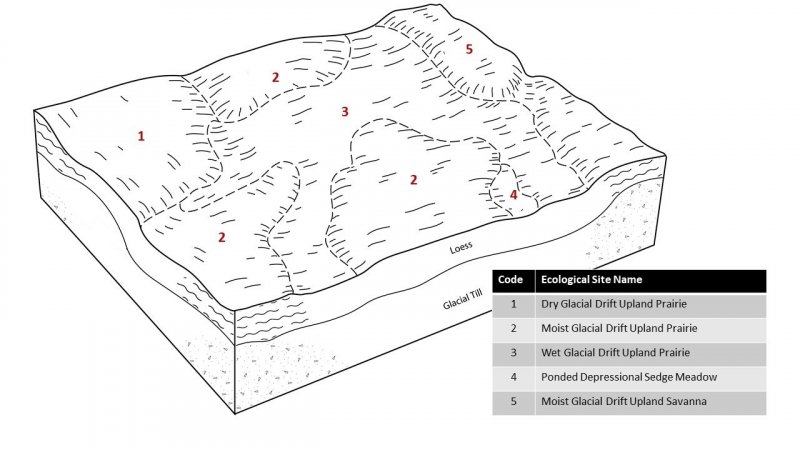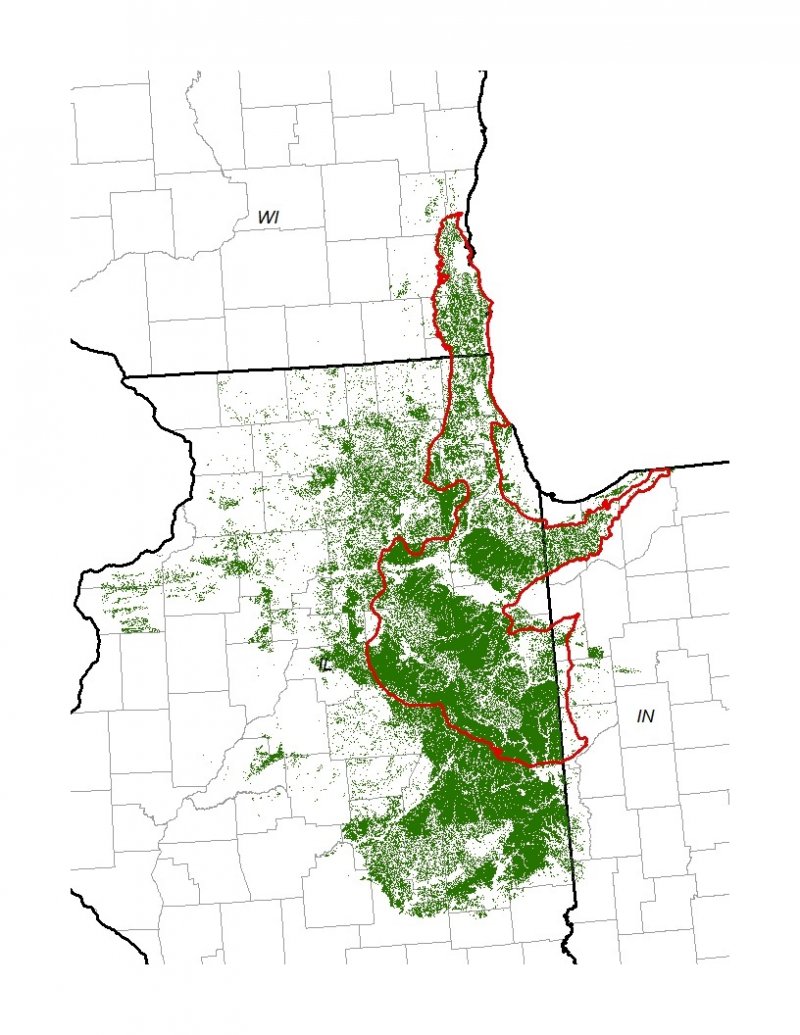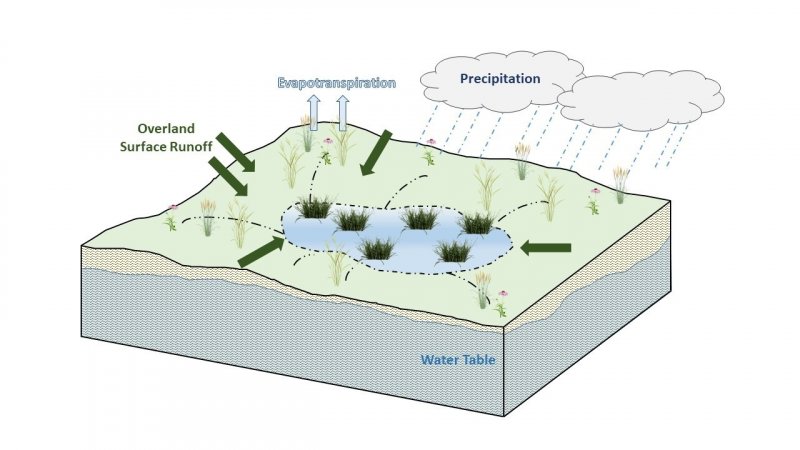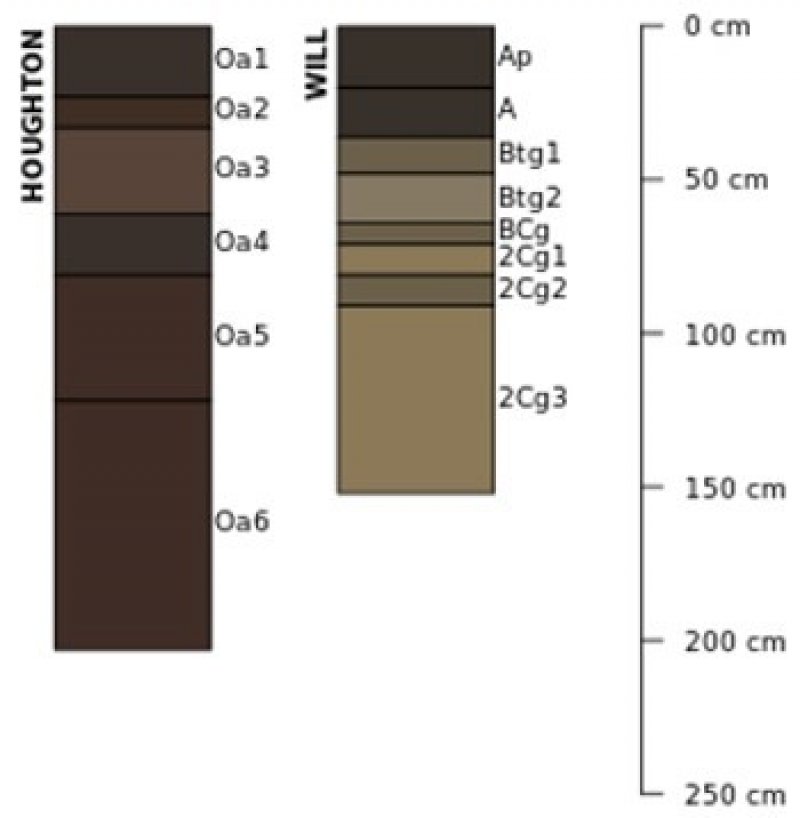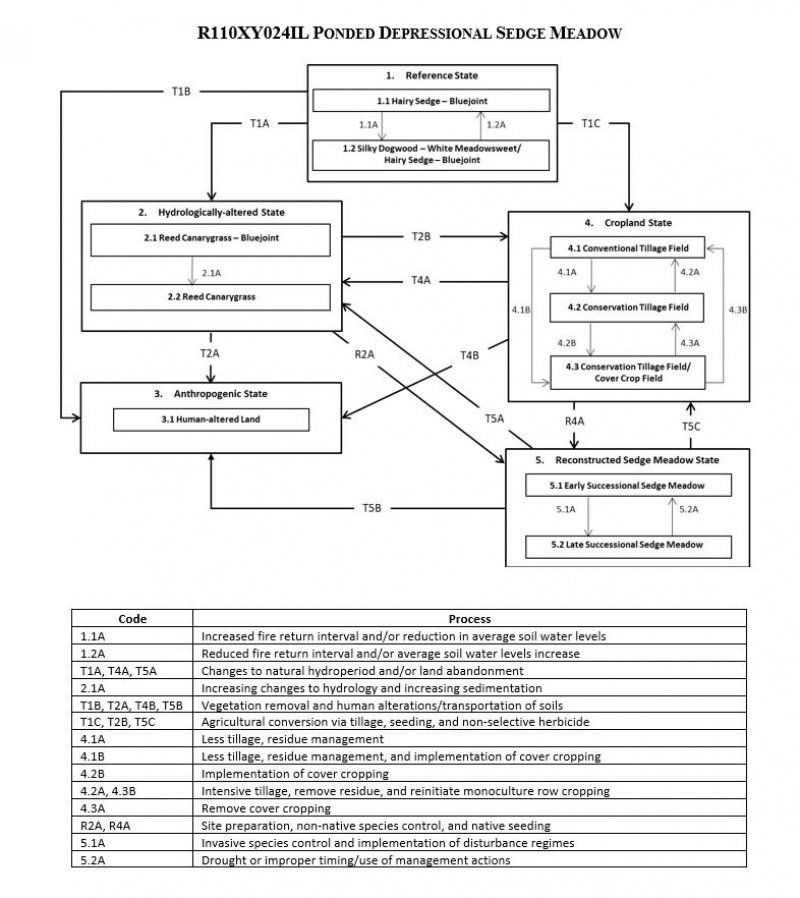Ecological dynamics
The information in this Ecological Site Description, including the state-and-transition model (STM), was developed based on historical data, current field data, professional experience, and a review of the scientific literature. As a result, all possible scenarios or plant species may not be included. Key indicator plant species, disturbances, and ecological processes are described to inform land management decisions.
The MLRA lies within the tallgrass prairie ecosystem of the Midwest, but a variety of environmental and edaphic factors resulted in landscape that historically supported prairies, savannas, forests, and various wetlands. Ponded Depressional Sedge Meadows form an aspect of this vegetative continuum. This ecological site occurs on uplands on very poorly to poorly drained soils. Species characteristic of this ecological site consist of hydrophytic herbaceous vegetation.
Ponding and fire are the most important ecosystem drivers for maintaining this ecological site. The depth and duration of ponding affect species composition, cover, and vegetative production due to alternating aerobic and anaerobic surface substrate conditions. Replacement fires likely occurred on a ten-year rotation interval and helped to reduce the accumulation of peat. The combination of fire and high-water levels prevented the establishment of shrubs for any significant amount of time (LANDFIRE 2009).
Drought has also played a role in shaping this ecological site. The periodic episodes of reduced soil moisture in conjunction with the very poorly to poorly drained soils have favored the proliferation of plant species tolerant of such conditions. Drought can slow the growth of plants and result in dieback of certain species. When coupled with fire, periods of drought can eliminate or greatly reduce the occurrence of woody vegetation, substantially altering the extent of shrubs and trees (Pyne et al. 1996).
Today, Ponded Depressional Sedge Meadows have been virtually eliminated as the land has mostly been converted to agricultural production. Corn (Zea mays L.) and soybeans (Glycine max (L.) Merr.) are the dominant crops grown. Some areas may have been converted to other human-modified landscapes. A return to the historic plant community is likely not possible due to significant hydrologic and water quality changes in the watershed, but long-term conservation agriculture or habitat reconstruction efforts can help to restore some natural diversity and ecological functioning. The state-and-transition model that follows provides a detailed description of each state, community phase, pathway, and transition. This model is based on available experimental research, field observations, literature reviews, professional consensus, and interpretations.
State 1
Reference State
The reference plant community is categorized as a sedge meadow community, dominated by hydrophytic herbaceous vegetation. The two community phases within the reference state are dependent on ponding and fire. The depth and duration of ponding alters species composition, cover, and extent, while regular fire intervals keep woody species from encroaching. Drought has more localized impacts in the reference phases, but does contribute to overall species composition, diversity, cover, and productivity.
Community 1.1
Hairy Sedge - Bluejoint
Sites in this reference community phase are dominated by sedges with grasses and forbs interspersed. Mature plants typically range between 1.5 and 3 feet tall, and ground cover is continuous (75 to 100 percent) (LANDFIRE 2009). Hairy sedge and bluejoint are the dominant species. Upright sedge, water sedge, rushes, and spikerushes area also present. Common forbs include spotted joe pye weed (Eutrochium maculatum (L.) E.E. Lamont), swamp milkweed (Asclepias incarnata L.), and white panicle aster (Symphyotrichum lanceolatum (Willd.) G.L. Nesom ssp. lanceolatum var. lanceolatum) (White and Madany 1978; NatureServe 2018).
Community 1.2
Silky Dogwood - White Meadowsweet/Hairy Sedge - Bluejoint
This reference community phase can occur when the frequency and depth of ponding are reduced such as from periodic drought. This phase can also occur when fire return intervals increase. The community assumes more of a shrub-carr assemblage, and shrubs, such as silky dogwood and white meadowsweet, become more prominent in the community encompassing at least 25 percent cover (NatureServe 2018). Sedges and forbs are still present but are likely reduced in areas where shrubs create pockets of shade (LANDFIRE 2009).
Pathway 1.1A
Community 1.1 to 1.2
Increased fire return intervals and/or periodic drying results in a reduction of the average soil water levels.
Pathway 1.2A
Community 1.2 to 1.1
Reduced fire return intervals and/or average soil water levels rise.
State 2
Hydrologically-Altered State
Hydrology is the most important determinant of wetlands and wetland processes. Hydrology modifies and determines the physiochemical environment (i.e., sediments, soil chemistry, water chemistry) which in turn directly affects the vegetation, animals, and microbes (Mitsch and Gosselink 2007). Human activities on landscape hydrology have greatly altered Ponded Depressional Sedge Meadows. Alterations such as agricultural tile draining and conversion to cropland on adjacent lands have changed the natural hydroperiod, increased the rate of sedimentation, and intensified nutrient pollution (Werner and Zedler 2003; Mitsch and Gosselink 2007).
Community 2.1
Reed Canarygrass - Bluejoint
This community phase represents the early changes to the natural wetland hydroperiod, sedimentation, and nutrient runoff. Sedimentation results in a reduction of soil organic matter and high dry bulk density. It also leads to a homogenization of the local microtopography, reducing the surface area and associated species diversity (Green and Galatowitsch 2002; Werner and Zedler 2002). Bluejoint and some sedges continues to form a component of the herbaceous layer, but the highly invasive reed canarygrass (Phalaris arundinacea L.) co-dominates.
Community 2.2
Reed Canarygrass
Sites falling into this community phase have experienced significant sedimentation and are dominated by a monoculture of reed canarygrass. Reed canarygrass stands can significantly alter the physiochemical environment as well as the biotic communities, making the site only suitable to reed canarygrass. These monotypic stands create a positive feedback loop that perpetuates increasing sedimentation, altered hydrology, and dominance by this non-native species, especially in sites affected by nutrient enrichment from agricultural runoff (Vitousek 1995; Bernard and Lauve 1995; Green and Galatowitsch 2002; Werner and Zedler 2002; Kercher et al. 2007; Waggy 2010).
Pathway 2.1A
Community 2.1 to 2.2
Continuing alterations to the natural hydrology and increasing sedimentation.
State 3
Anthropogenic State
The anthropogenic state occurs when the reference state is cleared and developed for human use and inhabitation, such as for commercial and housing developments, landfills, parks, golf courses, cemeteries, earthen spoils, etc. The native vegetation has been removed and soils have either been altered in place (e.g. cemeteries) or transported from one location to another (e.g. housing developments). Most of the soils in this state have 50 to 100 cm of overburden on top of the natural soil. This natural material can be determined by observing a buried surface horizon or the unaltered subsoil, till, or lacustrine parent materials. This state is generally considered permanent.
Community 3.1
Human-altered land
Sites in this community phase have had the native plant community removed and soils heavily re-worked in support of human development projects.
State 4
Cropland State
The continuous use of tillage, row-crop planting, chemicals (i.e., herbicides, fertilizers, etc.), and subsurface tile drainage has effectively eliminated the reference community and many of its natural ecological functions in favor of crop production. Corn and soybeans are the dominant crops for the site, and common wheat (Triticum aestivum L.) and alfalfa (Medicago sativa L.) may be rotated periodically. These areas are likely to remain in crop production for the foreseeable future.
Community 4.1
Conventional Tillage Field
Sites in this community phase typically consist of monoculture row-cropping maintained by conventional tillage practices. They are cropped in either continuous corn or corn-soybean rotations. The frequent use of deep tillage, low crop diversity, and bare soil conditions during the non-growing season negatively impacts soil health. Under these practices, soil aggregation is reduced or destroyed, soil organic matter is reduced, erosion and runoff are increased, and infiltration is decreased, which can ultimately lead to undesirable changes in the hydrology of the watershed (Tomer et al. 2005).
Community 4.2
Conservation Tillage Field
This community phase is characterized by rotational crop production that utilizes various conservation tillage methods to promote soil health and reduce erosion. Conservation tillage methods include strip-till, ridge-till, vertical-till, or no-till planting systems. Strip-till keeps seedbed preparation to narrow bands less than one-third the width of the row where crop residue and soil consolidation are left undisturbed in-between seedbed areas. Strip-till planting may be completed in the fall and nutrient application either occurs simultaneously or at the time of planting. Ridge-till uses specialized equipment to create ridges in the seedbed and vegetative residue is left on the surface in between the ridges. Weeds are controlled with herbicides and/or cultivation, seedbed ridges are rebuilt during cultivation, and soils are left undisturbed from harvest to planting. Vertical-till systems employ machinery that lightly tills the soil and cuts up crop residue, mixing some of the residue into the top few inches of the soil while leaving a large portion on the surface. No-till management is the most conservative, disturbing soils only at the time of planting and fertilizer application. Compared to conventional tillage systems, conservation tillage methods can improve soil ecosystem function by reducing soil erosion, increasing organic matter and water availability, improving water quality, and reducing soil compaction.
Community 4.3
Conservation Tillage Field/Alternative Crop Field
This community phase applies conservation tillage methods as described above as well as adds cover crop practices. Cover crops typically include nitrogen-fixing species (e.g., legumes), small grains (e.g., rye, wheat, oats), or forage covers (e.g., turnips, radishes, rapeseed). The addition of cover crops not only adds plant diversity but also promotes soil health by reducing soil erosion, limiting nitrogen leaching, suppressing weeds, increasing soil organic matter, and improving the overall soil ecosystem. In the case of small grain cover crops, surface cover and water infiltration are increased, while forage covers can be used to graze livestock or support local wildlife. Of the three community phases for this state, this phase promotes the greatest soil sustainability and improves ecological functioning within a cropland system.
Pathway 4.1A
Community 4.1 to 4.2
Tillage operations are greatly reduced, crop rotation occurs on a regular interval, and crop residue remains on the soil surface.
Pathway 4.1B
Community 4.1 to 4.3
Tillage operations are greatly reduced or eliminated, crop rotation occurs on a regular interval, crop residue remains on the soil surface, and cover crops are planted following crop harvest.
Pathway 4.2A
Community 4.2 to 4.1
Intensive tillage is utilized, and monoculture row-cropping is established.
Pathway 4.2B
Community 4.2 to 4.3
Cover crops are implemented to minimize soil erosion.
Pathway 4.3B
Community 4.3 to 4.1
Intensive tillage is utilized, cover crop practices are abandoned, monoculture row-cropping is established, and crop rotation is reduced or eliminated.
Pathway 4.3A
Community 4.3 to 4.2
Cover crop practices are abandoned.
State 5
Reconstructed Sedge Meadow State
Sedge meadow habitats provide multiple ecosystem services including flood abatement, water quality improvement, and biodiversity support. However, many sedge meadow communities have been stressed from watershed-scale changes in hydrology or eliminated due to type conversions to agricultural production, thereby significantly reducing these services (Zedler 2003). The extensive alterations of lands adjacent to Ponded Depressional Sedge Meadows may not allow for restoration back to the historic reference condition. However, ecological reconstruction can aim to aid the recovery of degraded, damaged, or destroyed functions. A successful reconstruction will have the ability to structurally and functionally sustain itself, demonstrate resilience to the natural ranges of stress and disturbance, and create and maintain positive biotic and abiotic interactions (SER 2002; Mitsch and Jørgensen 2004).
Community 5.1
Early Successional Sedge Meadow
This community phase represents the early community assembly from sedge meadow reconstruction and is highly dependent on seed viability, hydroperiod, soil organic matter content, and site preparation. Successful establishment of sedges can be maximized by using seed collected during the same growing season, utilizing genotypes adapted to the environmental location, ensuring soil moisture is saturated at the time of seeding, and improving the water holding capacity and fertility of the soil (Budelsky and Galatowitsch 1999; van der Valk et al. 1999; Mitsch and Gosselink 2007; Hall and Zedler 2010). In addition, suppression and removal of non-native species is essential for reducing competition (Perry and Galatowitsch 2003).
Community 5.2
Late Successional Sedge Meadow
Appropriately timed disturbance regimes (e.g., hydroperiod, prescribed fire) and nutrient management applied to the early successional community phase can help increase the species richness, pushing the site into a late successional community phase over time (Mitsch and Gosselink 2007).
Pathway 5.1A
Community 5.1 to 5.2
Maintenance of proper hydrology and nutrient balances in line with a developed wetland management plant.
Pathway 5.2A
Community 5.2 to 5.1
Reconstruction experiences a setback from extreme weather event or improper timing of management actions.
Transition T1A
State 1 to 2
Direct and indirect alterations to the landscape hydrology from human-induced land development transition the site to the hydrologically-altered state (2).
Transition T1B
State 1 to 3
Vegetation removal and human alterations/transportation of soils transitions the site to the anthropogenic state (3).
Transition T1C
State 1 to 4
Installation of drain tiles, seeding of agricultural crops, and non-selective herbicide transition the site to the cropland state (4).
Transition T2A
State 2 to 3
Vegetation removal and human alterations/transportation of soils transitions the site to the anthropogenic state (3).
Transition T2B
State 2 to 4
Installation of drain tiles, seeding of agricultural crops, and non-selective herbicide transition the site to the cropland state (4).
Restoration pathway R2A
State 2 to 5
Hydroperiod restoration, site preparation, non-native species control, and seeding native species transition the site to the reconstructed sedge meadow state (5).
Transition T4A
State 4 to 2
Agricultural production abandoned and left fallow; natural succession by opportunistic species transition this site to the hydrologically-altered state (2).
Transition T4B
State 4 to 3
Vegetation removal and human alterations/transportation of soils transition the site to the anthropogenic state (3).
Restoration pathway R4A
State 4 to 5
Hydroperiod restoration, site preparation, non-native species control and seeding native species transition this site to the reconstructed sedge meadow state (5).
Transition T5A
State 5 to 2
Land is abandoned and left fallow; natural succession by opportunistic species transition this site to the hydrologically-altered state (2).
Transition T5B
State 5 to 3
Vegetation removal and human alterations/transportation of soils transitions the site to the anthropogenic state (3).
Transition T5C
State 5 to 4
Installation of drain tiles, seeding of agricultural crops, and non-selective herbicide transition the site to the cropland state (4).

